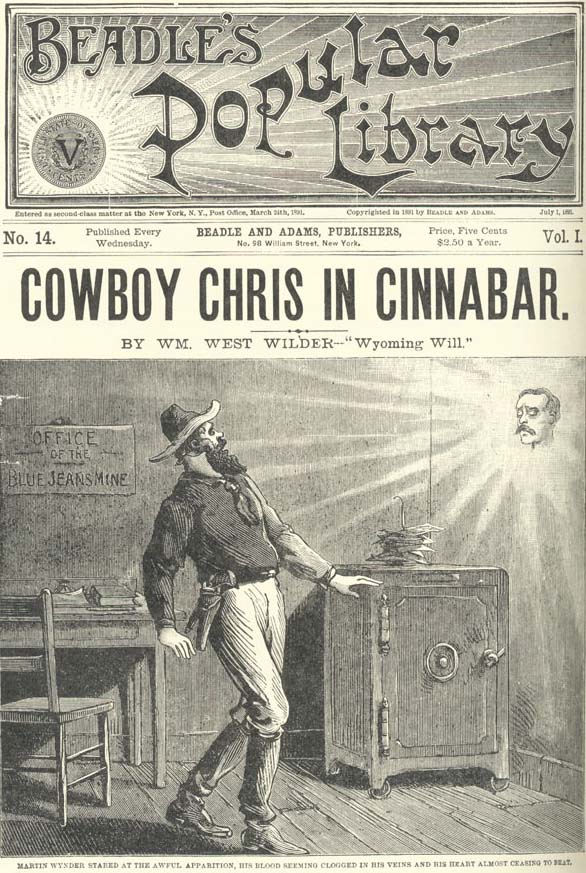Beadle's Popular Library
WITH a rather unattractive, plain heading, looking more like Ivers' Campfire
Library than a Beadle publication, a new Library made its first appearance
on April 1, 1891. Seven years had elapsed since the beginning of the next preceding
series. Beadle's Popular Library (Fig. 88),
as the new series was called, is a thin quarto of sixteen three-column pages,
11¾ by 8½ inches in size, and with a black line engraving on
the front page. It sold for five cents or $2.50 a year, and was issued every
Wednesday. It was the last effort of Beadle and Adams, still at 98 William Street,
to recapture the nickel novel trade which had been growing poorer and poorer
since the introduction of the degenerate, gaudy, colored-cover novels by their
competitors.
With only six exceptions, the stories in the new series are all new; and
for some reason or other, perhaps to infuse new life into a slowly dying business,
the authors also, for the most part, are camouflaged as new. The only previously
used name among them, except those given as authors of No. 43 — a reprint
— is Charles Morris. Perhaps the reason his name appeared is that he may
also have written some of the stories in this series under a pseudonym as well.
Of the remaining names, some have definitely been determined to be pseudonyms
of regular Beadle authors; thus Edward L. Wheeler's reprinted stories appeared
under the name Edward Lytton, William G. Patten masqueraded as William West
Wilder, T. C. Harbaugh as Major S. S. Scott, Arthur C. Grissom as Albert Cecil
Gaines, Prentiss Ingraham as T. W. King, and William H. Manning as Marcus H.
Waring. Among the remainder, not a single one is known to be real, and
it is more than probable that they are all pseudonyms of regular Beadle contributors.
Here appeared for the first time the names of Robert Randolph Inman, Redmond
Blake, Frank Fort, Edward Gaines Burnes, and T. J. Flanagan, but it is very
unlikely that Beadle, at this late date, was taking on any new writers. Writing
for Beadle, besides those mentioned above, there still remained the old crew,
Badger, Jenks, Cowdrick, Albert Aiken, Eyster, Whitson, and Leon Lewis, and
it is probable that among these and the authors previously mentioned are to
be found the true names of the unknowns.
Most of the novelettes are detective stories or late-type Westerns written
especially for this library and appearing here for the first time. All of them
were later reprinted in the Half-Dime Library. They are pale and feeble
imitations of the early red-blooded Half-Dimes. Perhaps the authors were
"written out," or realized that this type of story was on its last
legs and so made no effort to keep up the interest. Perhaps, also, the series
was not advertised enough. Beadle, in his own publications, so far as I know,
listed them only once in a Half-Dime Library and a number of times in
the Banner Weekly, Vols. IX and X. They were apparently never listed
elsewhere. Whatever the reason, the series was not a success, and ended in less
than a year with No. 48, on February 24, 1892. Two more numbers were announced
but were never issued. With its cessation, there remained only a few publications
to which new numbers were hereafter added by Beadle & Adams — the Half-Dime
Library, Dime Library, Pocket Library, and Banner Weekly. The firm
was slipping.

Fig. 88. Beadle's Popular Library
The last novel series begun by the firm; 48 numbers were issued in 1891 and
1892
Size of original, 11½ x 8½ inches
REDUCED

